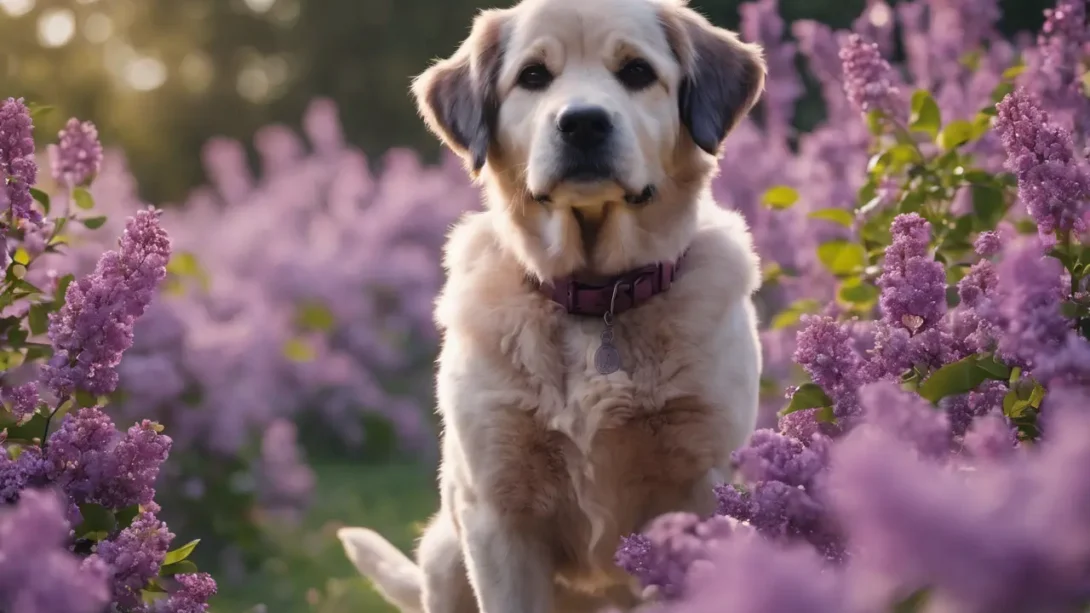Lilac bushes (Syringa spp.) are cherished by gardeners worldwide for their fragrant and colorful blooms. These perennial shrubs not only add aesthetic appeal to gardens but also bring the delightful scent of spring and early summer into the air. However, for pet owners, particularly dog owners, the question of whether these beautiful plants are safe around their furry friends often arises. This guide aims to address these concerns, providing detailed information about the toxicity of lilac bushes to dogs and offering peace of mind to those who share their gardens with pets.
Lilac Bushes
Lilac bushes are known for their vibrant flowers, which range in color from purple and lavender to white and pink, depending on the variety. They typically bloom for several weeks in late spring, though some varieties have been bred for extended blooming periods or reblooming capabilities. Lilacs are hardy, easy to care for, and can grow in a variety of climates, making them a popular choice for gardeners looking to add both color and fragrance to their outdoor spaces.
Aside from their ornamental value, lilacs have a rich history and have been a symbol of love and renewal in many cultures. Their lush foliage and dense growth habit also make them excellent choices for privacy hedges or standalone specimens in landscape designs.
Toxicity of Lilac Bushes to Dogs
When it comes to the safety of pets, particularly dogs, it’s essential to understand the toxicity of various plants. Many common garden plants can pose risks to our canine companions, leading to mild to severe health issues if ingested. However, lilac bushes are among the plants considered to be non-toxic to dogs. This section of the guide delves into the specific components of lilac bushes, such as leaves, flowers, bark, and seeds, and examines the scientific findings regarding their potential toxicity to pets.
Research and expert opinions from veterinary professionals have consistently shown that lilac bushes do not contain toxic substances that would pose a health risk to dogs if ingested in small quantities. While no plant material is recommended for consumption by pets, and eating large amounts of any non-food plant can potentially lead to gastrointestinal upset, lilacs are generally regarded as safe for dogs. This reassurance allows pet owners to enjoy the beauty and fragrance of lilac bushes in their gardens without undue concern for their pet’s safety.
Toxicity of Lilac Bushes to Dogs
When it comes to the safety of dogs around garden plants, one of the primary concerns for pet owners is the potential toxicity of those plants. Specifically, for lilac bushes (Syringa spp.), it’s essential to understand their impact on canine health. Lilac bushes, thankfully, are considered non-toxic to dogs. This categorization applies to all parts of the plant, including leaves, flowers, bark, and seeds. Scientific research and anecdotal evidence from veterinarians and pet owners align in indicating that lilacs do not pose a poisoning risk to dogs under normal circumstances. However, it’s always prudent to monitor any plant ingestion by pets, as individual reactions can vary, and excessive consumption of non-food items can lead to gastrointestinal distress.
Signs of Poisoning in Dogs
While lilac bushes are not toxic to dogs, it’s vital for pet owners to recognize the general signs of poisoning in their pets. Symptoms can range from mild to severe and may include vomiting, diarrhea, lethargy, drooling, increased heart rate, and in more serious cases, seizures or collapse. If a dog ingests a significant amount of any plant, including lilacs, they may experience gastrointestinal upset simply due to the unusual material in their stomach, not because the plant is inherently toxic. Knowing the signs of distress can help owners act quickly in any situation where their dog has ingested unfamiliar plant material.
What to Do If Your Dog Ingests Lilac Bushes
In the event that a dog ingests part of a lilac bush or shows signs of gastrointestinal upset after being around one, the first step is to assess the situation calmly. Generally, since lilacs are not toxic, mild ingestion usually doesn’t require emergency intervention. However, if a dog exhibits any symptoms of distress or if there’s concern about the amount ingested, contacting a veterinarian is a wise precaution. Pet owners should be ready to inform the vet about the plant ingested, the amount, and any symptoms observed. In most cases, the advice will be to monitor the dog for any escalation of symptoms and to provide supportive care, such as ensuring they stay hydrated and comfortable.
Safe Gardening Practices for Pet Owners
Creating a garden that is both beautiful and safe for pets is a priority for many homeowners. To ensure the safety of pets in the garden, it’s essential to select plants that are known to be non-toxic, like lilac bushes (Syringa spp.). However, pet owners should still practice safe gardening habits to prevent any potential risks. This includes:
- Researching Plants Before Planting: Always verify the safety of plants before introducing them into your garden. Numerous resources are available, including ASPCA’s list of non-toxic and toxic plants for pets.
- Garden Layout Considerations: Design your garden in a way that minimizes pets’ access to any plants you’re unsure about. Using raised beds or physical barriers can help keep pets away from specific areas.
- Alternative Plants: For areas where pets have access, consider planting exclusively non-toxic plants. If you love the look of lilacs but are concerned about other plants’ toxicity, seek out similar non-toxic alternatives to popular but poisonous garden plants.
Conclusion
Lilac bushes, with their fragrant flowers and lush foliage, are a delightful addition to any garden and, importantly, are safe for dogs. While they pose no toxic risk to our canine companions, it’s a reminder of the importance of responsible pet ownership and garden planning. By choosing pet-safe plants and implementing strategies to keep our furry friends safe, we can enjoy the beauty and tranquility of our gardens with peace of mind.
The joy of gardening can be enhanced by considering the well-being of all family members, including pets. With careful selection and arrangement of plants, like the non-toxic lilac bush, gardens can be a safe and enjoyable space for everyone. As we nurture our plants, let’s also protect and cherish the health and safety of our pets, ensuring our gardens are places of happiness and harmony for all.




